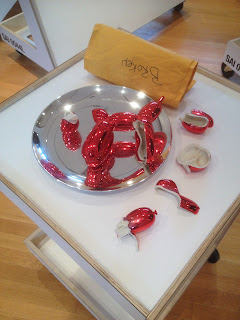“WE NOW ENCLOSE HEREWITH PROOF OF LOSS.”
This fateful declaration greets visitors at the door to No Longer Art, an exhibit presented by the Salvage Art Institute (SAI) and Columbia University with the cooperation of AXA Art. In fact, the exhibit wouldn’t even be possible without the help of the insurance firm AXA because every piece on display is the remnant of an insurance claim. SAI, a non-profit organization, has accumulated a collection of damaged artworks deemed total losses by AXA after owner's claims are paid. The objects themselves are then consigned to a sort of purgatory by the insurer. Physically speaking they are still sculptures, drawings, photographs and painting; but their status as "art" has been officially revoked.
Or has it …? How was this exhibit like and yet unlike viewing “real” art? The show space itself is a small meeting room at the University of Chicago’s Neubauer Collegium for Culture and Society. Dozens of ex-artworks cluttered the room on wheeled carts as if they had been pulled directly from storage. But this is not careless curation. Each numbered piece comes with corresponding documentation of the original insurance claim (with specific details appropriately redacted) in booklets mounted on small shelves against the walls of the room. I found myself trying to match up claims with the carts that had been shuffled around by previous visitors. The stories of damage and destruction are on display as much as the objects themselves. Unlike the shattered “Balloon Dog” by Jeff Koons, some damage (as described) wasn't readily apparent to me. More than once I had to look hard for it -- I had no luck spotting the "mold contamination" on one drawing.
Viewers can handle everything on display which was definitely the best part of the experience. "When else will you touch a Jeff Koons?" said a visitor as she and her friend attempted to fit the broken pieces of shiny red ceramic back in place. A certain reverence has been removed by no longer calling these objects "art" and declaring them void of all monetary value. This change carries with it an immunity to further harm. I ran my hand across a graphite/paper diptych by Linda Bond and came up with smudged fingers. I would never do such a thing in a traditional gallery or museum! And yet being able to touch this “stuff” that was made by accomplished, even famous, artists somehow made them seem more real. I didn’t revere these objects but still respected them and their creators.
It’s one thing to damage an artwork irreparably. To actually rescind an object’s identity as "art" requires some clever wordplay. An exhibit like this comes with its share of rhetoric. According to SAI, “the signature of the adjuster meets and cancels the signature of the artist.” “Salvage art,” “total loss” and “transformation” are a few more tools in their lexicon. In her Chicago Tribune review, columnist Lori Waxman perceives the salvaged art as "invisible" pieces "hidden in plain sight".
I felt like I had walked into an haute version of the Island of Misfit Toys. Rather than cast their collection as misfit art, SAI chose to curate No Longer Art with empowering rhetoric – freedom! Through damage and destruction, these pieces have been “liberated from the obligation of perpetual valuation and exchangeability.” The mercurial art market is implied to be a source of oppression. And that cluttered, moveable layout? It is an intentional statement of democracy – no art historical hierarchy or classification system governs this exhibit. The order of the pieces can be changed at will by the viewers themselves.
I felt like I had walked into an haute version of the Island of Misfit Toys. Rather than cast their collection as misfit art, SAI chose to curate No Longer Art with empowering rhetoric – freedom! Through damage and destruction, these pieces have been “liberated from the obligation of perpetual valuation and exchangeability.” The mercurial art market is implied to be a source of oppression. And that cluttered, moveable layout? It is an intentional statement of democracy – no art historical hierarchy or classification system governs this exhibit. The order of the pieces can be changed at will by the viewers themselves.
SAI is actively developing plans for a permanent exhibit space in New York City. In the meantime, No Longer Art is open at the Neubauer Collegium for Culture and Society and runs through June 26, 2015. The University of Chicago will present a special symposium in conjunction with the exhibit on June 5 from 3-6 pm. The event is called Salvage Art 2.1 (2.0 took place last month) and will be led by Dr. Christine Mehring, chair of the university’s Art History Department.





No comments:
Post a Comment